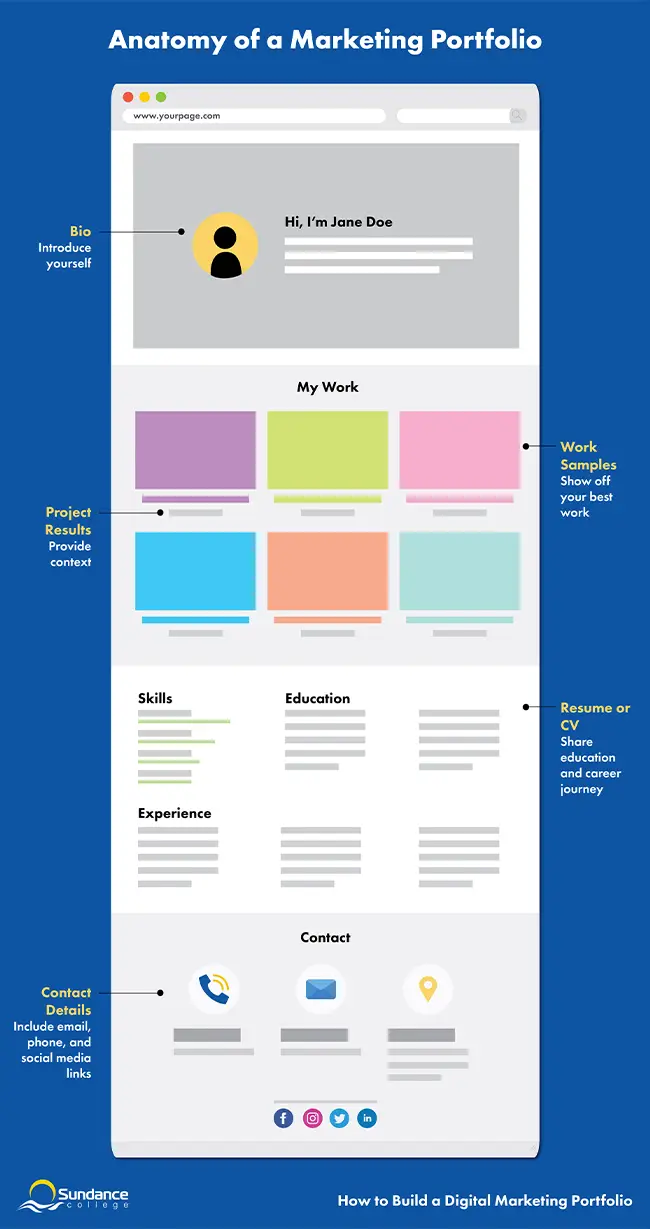Blog / How to Build a Digital Marketing Portfolio
How to Build a Digital Marketing Portfolio

Digital Marketing and Social Media Management Diploma
- Digital Marketing Assistant/Coordinator
- Advertising Account Executive
- Marketing Assistant/Coordinator
- Content Marketer
Table of Contents
If you’re dreaming of a career in marketing, it’s never too early to start preparing your professional portfolio. Think about it this way: the earlier you start, the more time you can invest in assembling a portfolio that captures your unique marketing style and skillset.
For new marketers, creating a portfolio may sound intimidating – or even impossible. How can you show examples of projects you’ve worked on if you need those examples to get hired in the first place?
Enrolling in a digital marketing diploma program is a great way to generate creative work for your portfolio – and of course, learn marketing fundamentals required to succeed in the field. Even better, programs with marketing practicums allow you to put your ideas to the test. There’s nothing better than backing up stunning creative work with hard data (but we’ll get to that in just a moment).
Keep reading to learn how to create a marketing portfolio that will land you your dream job after graduation.
What is a Marketing Portfolio?

Marketing portfolios help you market yourself to potential employers and clients. Whether you’re applying for an in-house or agency job, you’ll be required to submit a portfolio during the application process. Every marketer needs a portfolio, including copywriters, social media managers, and graphic designers.
Your portfolio should demonstrate your marketing knowledge and skills, and convey your personal brand. Hiring managers will expect to see examples of your creative work (with results), your CV, and a bio that tells your career story.
You should update your portfolio whenever you complete a new project or change employers, and do a thorough review every January. The first month of the year is the perfect time to refresh your portfolio and prepare for upcoming opportunities.
What Should Be Included in a Professional Portfolio?

Every marketing portfolio should have the following 5 sections:
1. Portfolio Bio
Bios are typically placed at the beginning of the portfolio. This is the section where you introduce yourself and share a summary of your career and achievements.
This section tends to be brief – only 3 to 6 sentences – and can be written in either first or third person, depending on your preference. Because it’s so short, every word of your bio counts, so think carefully about what a potential employer should know about you.
Here is some key information to include:
- Your name
- A one-sentence summary of your career/area of expertise
- Your current or most recent employer
- 1-3 achievements
- Your career goals
The language in your bio should reflect the type of marketing work you want to do. If you’d love to work for a fun, youthful company that markets to a Gen Z audience, you may not want your bio to read as overly formal. Similarly, if you’re applying to an agency that primarily caters to non-profits, a casual or quirky bio could suggest you’re not the best fit for the role.
Choosing the best voice for your bio will depend on your professional goals and how you want to be perceived as a marketer.
2. Work Samples
Have you heard the advice, “show, don’t tell?”
While your bio tells employers how great you are at your job, work samples show what you’ve created. This section should consist of 3 to 5 examples of your best work.
The format of your portfolio, and your area of expertise, will determine whether you embed images of your work or link to your samples (or a combination of the two). For example, if you’re a copywriter, you might choose to link the blog articles you’ve written, but also embed images of an ad campaign you worked on.
When selecting work samples to include, look for work that best represents your skills and interests as a marketer and projects that achieved positive results. It’s also worth considering which companies will be viewing your portfolio, and even creating multiple versions if you have samples that cater to different industries.

3. Project Results
Placing a project summary next to each work sample will provide important context for potential employers. Your summary should explain:
- Who the project was created for
- The project’s goals or purpose
- Your specific contributions
- Performance results
Data is one of the best ways to speak to a project’s success. For example, you might include the number of monthly readers your blog has, how many leads your ad campaign generated, or the increase in social media followers you achieved over a specific time frame. If the project was created for a marketing class, break down your creative approach and explain why you would expect the decisions you made to achieve the intended results.
Overall, this section should speak to the reason your project was created and how it supported your client or employer’s marketing goals.
4. Resume Or CV
Like any resume or curriculum vitae, this section of your portfolio should share your education and work experience with potential employers – including practicum placements.
For tips on creating a standout resume, take a look at this blog article we wrote.
5. Contact Details
If you want to hear from interested employers (and of course you do), don’t forget to provide your contact information! This includes your email and phone number, as well as links to social media accounts you use professionally.
Some online portfolio websites also allow you to create a lead form, which is a useful strategy if you’re a freelance marketer.
What is an Online Portfolio?
Today, most marketers build their portfolios as a website, which people can access via a link or Google search.
Creating an online portfolio enables you to:
- Reach more potential clients through your web presence
- Send your portfolio as a URL instead of a large file attachment
- Embed your portfolio within your resume
- Organize your portfolio into multiple webpages
- Incorporate interactive design into your portfolio
- Link to other websites, social channels, and projects
- Easily update your work samples and resume
Many website builders charge a fee for use, but some free options do exist. Here are 5 popular website builders used for digital portfolios:
- Canva Portfolio Website Builder (Free)
- WordPress (Free)
- Journo Portfolio (Free)
- Squarespace
- Wix
What Makes a Good Digital Marketing Portfolio?
You may think the quality of your portfolio hinges on your work samples, but this is only half of the equation. The best digital marketing portfolios tell a coherent story about who you are as a marketer, in addition to displaying skill and professionalism.
Every element of your portfolio, from your bio and work samples to your color palette, should communicate your personal brand. Think about the key characteristics that set you apart from other marketers and ways you can express this unique vision. Authenticity and originality will make your portfolio stand out from the competition.
Is Marketing a Good Career?

Marketing is an excellent career path for creative thinkers who value job stability and opportunities for advancement. Unlike many other jobs, marketing is a rewarding blend of art and science. Plus, constant innovations in technology mean you’ll never be bored as a digital marketer!
Another benefit of working in marketing is flexibility – marketers can work in many different industries, explore a wide variety of career paths, and even choose between traditional employment and freelancing. Because marketing touches so many different sectors, this career path is uniquely positioned to withstand fluctuations in the job market.
How to Become a Marketing Professional
The Digital Marketing and Social Media Management diploma at Sundance College prepares students for a range of marketing career possibilities, from copywriting to social media management. In this program, you’ll not only generate material for your portfolio through class assignments, you’ll also gain real-world skills and knowledge through a practicum with a local business!
Fill out this form to learn if you qualify for admission for our Digital Marketing Diploma Program.
Related Blogs
Subscribe for more career advice
Blog Categories
Share on:
